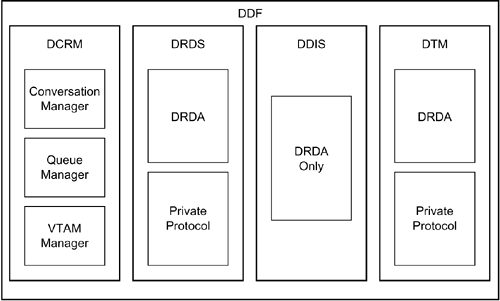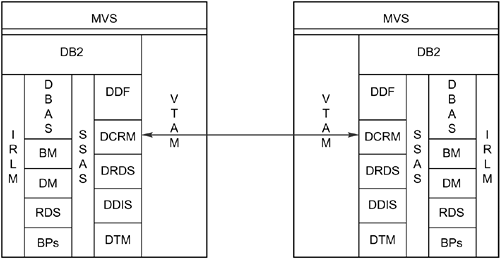Distribution Behind the Scenes
| < Day Day Up > |
| Distributed DB2 requests are carried out through the Distributed Data Facility (DDF). The DDF is implemented as an address space in the same manner as the other DB2 address spaces: DBAS, SSAS, and IRLM. Refer to Chapter 20, "DB2 Behind the Scenes," for additional information on these three address spaces. To more fully understand the workings of distributed data, see Figure 44.1 for a brief description of the components of the DDF. Figure 44.1. The Distributed Data Facility. The DDF is composed of four components:
The DCRM manages the interfaces to other resources with which the DDF must interact. The DCRM is the component that actually manages the connections (see Figure 44.2). The DCRM of the requester creates conversations to communicate to the server. The DCRM of the server accepts requests and creates a database access thread (DBAT) to handle distributed requests. Figure 44.2. Distributed communication. Three different managers within the DCRM enable you to perform these tasks : the conversation manager, the queue manager, and the VTAM manager. Connections are managed by the conversation manager (CM) . The CM is responsible for managing the receipt of messages from remote clients and sending messages from the server back to the requester. Furthermore, the CM manages the creation and termination of connections to support DRDA and private protocol requests. The queue manager (QM) creates and routes work requests for allied agents. Requests from allied agents are queued by the QM and then routed for further processing. The third and final component of the DCRM is the VTAM manager . The CM uses the VTAM manager to communicate with other DBMSs in the network. This component reads the CDB to determine how communication resources are to be used by DDF. The second component of the DDF is the Distributed Relational Data System (DRDS) . It performs tasks similar to those performed by the RDS (in the DBAS). For private protocol requests, the DRDS receives remote requests and invokes the local DCRM to communicate with the remote server DCRM. The server DCRM receives the request and passes it to the RDS of the server. For DRDA requests, the DRDS enables the requester to perform remote binds. The bind request is passed to the server, which uses its DRDS to kick off the bind. The Distributed Data Interchange System (DDIS) is the third component of the DDF. It is used only for DRDA requests. The DDIS performs object mapping of remote objects. Object mapping occurs at both the requester and server. The final DDF component is the Data Transaction Manager (DTM) . As its name implies, the DTM manages distributed transactions. It performs tasks such as monitoring for errors, controlling commits and aborts, and managing recovery. A firm understanding of the functionality embedded within each of these components can help the application developer or database analyst more fully comprehend the underlying operations required for supporting a distributed environment. |
| < Day Day Up > |
EAN: 2147483647
Pages: 388

